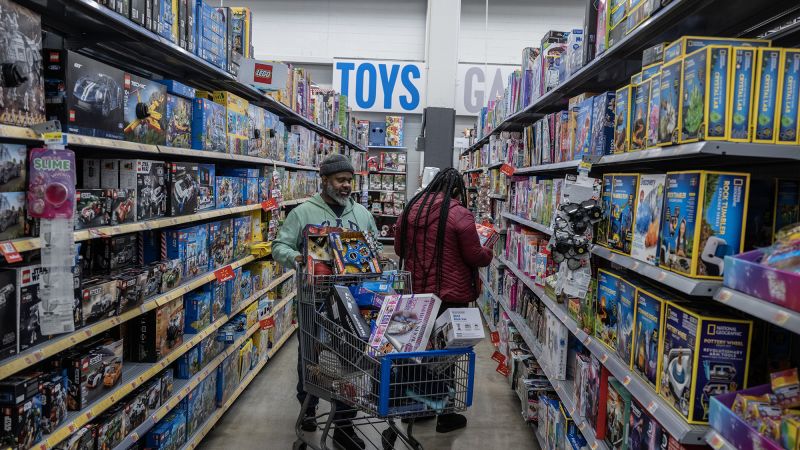New York
CNN
—
Consumers bought fewer toys in all of 2023, including during the key Christmas toy-buying period, showing that households continue to pare back on discretionary products.
The year-end gift-buying season typically accounts for a big chunk of annual toy sales. It’s why retailers entice shoppers with discounts and other incentives to revv up demand.
Especially during the holidays, parents tend to dig deep to afford and fulfill their child’s wishlist.
But toy sales in all of 2023 dropped 8%, both in dollar terms (how much consumers paid for toys) and in unit sales (meaning how many toys consumers bought). In just the fourth-quarter, which includes the Christmas season, toy sales also fell 8% and declined 6% in unit sales, according to a report from market research firm Circana.
This shows that shoppers bought fewer toys but also traded down in prices to cheaper toys. Circana said that the average selling price was down 2% in the fourth quarter.
“That really points to consumers choosing lower-priced toys,” said Juli Lennett, vice president and toy industry advisor at Circana, which collects register sales data from 78% of the retail market in the United States.
But Lennett said there’s a caveat worth noting: Compared to before the pandemic, or 2019, the toy industry has still logged an overall $5.7 billion sales increase.
Separate data released Friday from the Commerce Department shows that inflation-adjusted consumer spending on games, toys and hobbies increased on a monthly basis since August 2023, including netting the first positive monthly December gain since 2017.
“While 2023 was a challenging year for the U.S. toy industry, the four-year compound annual growth rate remains positive,” she said. “Over the pandemic, the industry gained an influx of new consumers, including adults. I’ve been speculating for the last year that we would start to see a decline back to normal pre-Covid levels.”
Regarding the government data, she said it was unclear what is included in the category. The Circana data, she said, does not include products such as bicycles and video games.
Still, the sales turbulence has taken a toll on at least one major player. Hasbro slashed nearly 20% of its workforce, or more than 1,000 workers, in December amid an ongoing slump in toy purchases.
Many households last year struggled with stubborn inflation making it still more expensive to buy products and pay for services they needed.
The effect of it, among other pressures on their finances, was depleted consumer savings and rising consumer credit card debt.
Yet, other indicators showed that American household ended the year with some relief: Incomes and wages were up considerably from the year before, and consumer spending persisted, helping to keep the economy growing and casting aside recession fears.
But going forward, Lennett pointed to one other factor weighing on arguably the most important demographic currently for toy purchases: student loan repayment and millennials.
Government data in December showed that nearly 9 million borrowers missed their first student loan payment after the pandemic-related pause ended last fall.
“The student loan issue, for me, is the biggest issue for the toy industry. They are a major consumer of toys because they have young children,” Lennett said. “From what we’ve seen from government data, the majority of borrowers for student loans are in this demo. So this is impacting our consumer more than any older age group or even the youngest age group.”
Jon Copestake, global consumer senior analyst with EY, agreed.
“While it is a tangential factor influencing consumption, student loan repayment together with the other ongoing challenges is collectively pushing down household finances,” Copestake said. “Toys are the ultimate discretionary items and the first thing that consumers will cut back on.”
Robby Pettinato said he’s aware of a shift in buying behavior among the parent demographic Toy Joy, a popular Austin-based toy store chain.
“Toy Joy has a unique take on a toy store because we cater to parents with young children and adult customers who are hobbyists and collectors. Historically, for almost four decades we’ve really been a store for all ages,” Pettinato, COO of Wild About Music, Inc., parent company of Toy Joy, said in an interview with CNN.
“Anecdotally, over the last year, I do feel there has been a decline the number of families that are shopping for new toys for their kids,” he said. “That’s not to say that demand for toys is going away but that it’s not lost on us that the young parent customer is also the most careful with their budget right now.”
At the same time, Pettinato said Toy Joy’s business has also experienced “exponential” growth in young millennial and Gen Z customers who are shopping for toys to add to their collection such as action figures or some other toy category that’s been trending on social media.
Among the toys that consumers did buy in 2023, Pokémon, Barbie and Squishmallows were the top three best-selling brands last year, according to Circana. The firm looked at what it called 11 toy “supercategories,” including dolls, plush toys, building sets, action figures, games and puzzles.
Rounding out the top 10 selling brands last year were Star Wars, Marvel, Hot Wheels, Fisher-Price, LEGO Star Wars, Disney Princess, and Melissa & Doug.
– CNN’s Alicia Wallace and Katie Lobosco contributed to this story
